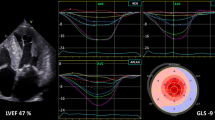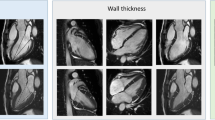Abstract
Left ventricular (LV) remodeling after myocardial infarction (MI) plays an important role in the progression of heart failure (HF). Changes in the shape, size, and function of the LV are caused by altered mechanical properties of the injured myocardium. As the survival rate after MI improves with medical advances, the incidence of HF patients increases. Hence, an accurate depiction of the LV remodeling process facilitates disease surveillance and monitoring of therapeutic efficacy. It may also help determine the choice of treatment, e.g., surgery to remove the infarcted wall segment and reduce the LV cavity size. Traditionally, there are several ways of characterizing LV remodeling: changes in LV diameter, LV volume, ejection fraction, and qualitative or semi-quantitative descriptors of LV shape. In this chapter, we present a new approach to quantify LV shape (in terms of curvedness), wall stress, and function by using computational modeling.
Similar content being viewed by others
References
Cohn JN, Ferrari R, Sharpe N. Cardiac remodeling – concepts and clinical implications: a consensus paper from an international forum on cardiac remodeling. Behalf of an International Forum on Cardiac Remodeling. J Am Coll Cardiol. 2000;35:569–382.
Maron BJ. Distinguishing hypertrophic cardiomyopathy from athlete’s heart: a clinical problem of increasing magnitude and significance. Heart 2005;91(11):1380–82.
Pfeffer JM, Pfeffer MA, Fletcher PJ, Braunwald E. Progressive ventricular remodeling rat with myocardialinfarction. Am J Physiol Heart Circ. 1991;260:H1406–14.
Ganau A, Devereux RB, Roman MJ. Patterns of left ventricular hypertrophy and geometric remodeling in essential hypertension. J Am Coll Cardiol. 1992;19(7):1559–60.
Cohen MV, Yang XM, Neumann T. Favorable remodeling enhances recovery of regional myocardial function in the weeks after infarction in ischemically preconditioned hearts. Circulation. 2000;102:579–83.
Zhong L, Su Y, Yeo SY, Tan RS, Ghista DN, Kassab GS. Left ventricular regional wall curvedness and wall stress in patients with ischemic dilated cardiomyopathy. Am J Physiol Heart Circ Physiol. 2009b;296(3):H573–84.
Greenberg B, Quinones MA, Koilpillai C, Limacher M, Shindler D, Benedict C, Shelton B. Effects of long-term enalapril therapy on cardiac structure and function in patients with left ventricular dysfunction. Circulation. 1995;91:2573–81.
The Digitalis Investigation Group. The effects of digoxin on morality and morbidity in patients with heart failure. N Engl J Med. 1997;336:525–33.
Rubin SA, Fishbein MC, Swan HJC. Compensatory hypertrophy in the heart after myocardial infarction in the rat. J Am Coll Cardiol. 1983;61:1435–41.
Gaballa MA, Goldman S. Ventricular remodeling in heart failure. J Card Fail. 2002;8:S476–85.
Mitchell GF, Lamas GA, Vaughan DE, Pfeffer MA. Left ventricular remodeling in the year after first anterior myocardial infarction: a quantitative analysis of contractile segment lengths and ventricular shape. J Am Coll Cardiol. 1992;19:1136–44.
Kono T, Sabbah HN, Steain PD, Brymer JF, Khaja F. Left ventricular shape as a determinant of mitral regurgitation in patients with several heart failures secondary to either coronary artery disease or idiopathic dilated cardiomyopathy. Am J Cardiol. 1991;68:355–9.
Kass DA, Trail TA, Keating M, Altieri PI. Abnormalities of dynamic ventricular shape change in patients with aortic and mitral valvular regurgitation: assessment by Fourier shape analysis and global geometric indexes. Circ Res. 1988;62:127–38.
Manici GB, DeBoe SF, Anselmo E, Simon SB. Quantitative regional curvature analysis: an application of shape determination of the assessment of segmental left ventricular function in man. Am Heart J. 1987;113:326–34.
Yeo SY, Zhong L, Su Y, Tan RS, Ghista DN. A curvature-based approach for left ventricular shape analysis from cardiac magnetic resonance imaging. Med Biol Eng Comput. 2009;47(3):313–22.
Radhakrishnan S, Ghista DN, Jayaraman G. Mechanical analysis of the development of left ventricular aneurysms. J Biomech. 1980;13:1031–9.
Litwin SE, Litwin CM, Raya TE, Warner A, Goldman S. Contractility and stiffness of noninfarcted myocardium following coronary ligation in rats: effects of chronic angiotensin converting enzyme inhibition. Circulation. 1991;83:1028–37.
Hirota Y, Shimizu G, Kaku K, Saito T, Kino M, Kawamura K. Mechanisms of compensation and decompensation in dilated cardiomyopathy. Am J Cardiol. 1984;54:1033–38.
Bing OH, Brooks WW, Conrad CH, Weinstein KB, Spadaro J, Padvany P. Myocardial mechanics of infarcted and hypertrophied non-infarcted myocardium following experimental coronary artery occlusion. In: International Erwin Riesch Symposium, 1983,pp. 235–44.
Borrow KM, Neumann A, Marcus RH. Effects of simultaneous alterations in preload and afterload on measurements of left ventricular contractility in patients with dilated cardiomyopathy: comparisons of ejection phase, isovolumetric and end-systolic force–velocity indexes. J Am Coll Cardiol. 1992;20:787–95.
Zile MR, Gaasch WH, Carroll JD. Chronic mitral regurgitation: predictive value of preoperative echocardiographic indexes of left ventricular function and wall stress. J Am Coll Cardiol. 1984;3:235–42.
Gunther S, Grossman W. Determinants of ventricular function in pressure-overload hypertrophy in man. Circulation. 1979;59:679–88.
Broughton A., Korner PI. Steady-state effects of preload and afterload on isovolumic indices of contractility in autonomically blocked dogs. Cardiovasc Res. 1980;14:245–53.
Suga H, Sagawa K, Shoukas AA. Load independence of the instantaneous pressure–volume ratio of the canine left ventricular and effects of epinephrine and heart rate on the ratio. Circ Res. 1973;32:314–22.
Zhong L, Ghista DN, Ng EY, Lim ST. Passive and active ventricular elastances of the left ventricle. Biomed Eng Online. 2005;4(1):14.
Kass DA, Beyer R. Evaluation of contractile state by maximal ventricular power divided by the square of end-diastolic volume. Circulation. 1991;84:1698–708.
Zhong L, Tan RS, Ghista DN, Ng EY, Chua LP, Kassab GS. Validation of a novel noninvasive cardiac index of left ventricular contractility in patients. Am J Physiol Heart Circ Physiol. 2007;292(6):H2764–72.
Zhong L, Sola S, Tan RS, Ghista DN, Kurra V, Navia JL, Kassab GS. Effects of surgical ventricular restoration on left ventricular contractility assessed by a novel contractility index in patients with ischemic cardiomyopathy. Am J Cardiol. 2009a;103:674–79.
Voigt JU, Lindenmeier G, Werner D, Flachskampf FA, Nixdorff U, Hatle L, Sutherland GR, Daniel WG. Strain rate imaging for the assessment of preload-dependent changes in regional left ventricular diastolic longitudinal function. J Am Soc Echocardiogr. 2002;15(1):13–19.
Walker JC, Ratcliffe MB, Zhang P, Wallace AW, Fata B, Hsu EW, Saloner D, Guccione JM. Magnetic resonance imaging-based finite element stress analysis after linear repair of left ventricular aneurysm. J Thorac Cardiovasc Surg. 2005a;135:1094–102.
Walker JC, Ratcliffe MB, Zhang P, Wallace AW, Fata B, Hsu EW, Saloner D, Guccione JM. MRI-based finite-element analysis of left ventricular aneurysm. Am J Physiol Heart Circ Physiol. 2005b;289:H692–700.
Yin FC. Ventricular wall stress. Circ Res. 1981;49:829–42.
Jana R. Estimation of local myocardial stress. Am J Physiol Heart Circ Physiol. 1982;242:H875–81.
Beyar R, Shapiro E, Graves W, Guier W, Carey G, Soulen R, Zerhouni E, Weisfeldt M, Weiss J. Quantification and validation of left ventricular wall thickening by a three-dimensional element magnetic resonance imaging approach. Circulation. 1990;81:297–307.
Linzbach AJ. Heart failure from the point of view of quantitative anatomy. Am J Cardiol. 1960;5:370–82.
Pouleur H, Rousseau MF, van Eyll C, Meilin J, Youngblood M, Yusuf S. Cardiac mechanics during development of heart failure. SOLVD Investigators. Circulation. 1993;87:V14–20.
Shannon RP, Komamura K, Shen YT, Bishop SP, Vatner SF. Impaired regional subendocardial coronary flow reserve in conscious dogs with pacing-induced heart failure. Am J Physiol Heart Circ Physiol. 1993;265:H801–09.
Drerup B, Hierholzer E. Objective determination of anatomical landmarks on the body surface: measurement of the vertebra prominens from surface curvature. J Biomech. 1985;18:467–74.
Liu X, Kim W, Drerup B, Mahadev A. Tibial torsion measurement by surface curvature. Clin Biomech. 2005;20:443–50.
Willmore TJ. An introduction to differential geometry. Oxford University Press, Delhi, 1985.
Koenderink JJ, van Doom AJ. Surface shape and curvature scales. Image Vis Comput. 1992;10:557–65.
Cerqueira MD, Weissman NJ, Dilsizian V, Jacobs AK, Kaul S, Laskey WK, Pennell DJ, Rumberger JA, Ryan T, Verani MS. Standardized myocardial segmentation and nomenclature for tomographic imaging of the heart: a statement for healthcare professional from the Cardiac Imaging Committee of the Council on Clinical Cardiology of the American Heart Association. Circulation. 2002;105:539–42.
Grossman W, Braunwald E, Mann T, McLaurin L, Green L. Contractile state of the left ventricle in man as evaluated from end-systolic pressure–volume relations. Circulation. 1977;56:845–52.
Reichek N, Wilson J, St. John Sutton M, Plappert, TA, Goldberg S, Hirshfeld JW. Noninvasive determination of left ventricular end-systolic stress: validation of the method and initial application. Circulation. 1982;65:99–108.
Walker JC, Ratcliffe MB, Zhang P, Wallace AW, Hsu EW, Saloner DA, Guccione JM. Magnetic resonance imaging-based finite element stress analysis after linear repair of left ventricular aneurysm. J Thorac Cardiovasc Surg. 2008;35:1094–1102.
Acknowledgments
This research was supported in part by National Heart Centre Research Grant and the National Institute of Health – National Heart, Lung, and Blood Institute Grant HL84529 and 2R01HL055554-11.
Author information
Authors and Affiliations
Corresponding author
Editor information
Editors and Affiliations
Rights and permissions
Copyright information
© 2010 Springer Science+Business Media, LLC
About this chapter
Cite this chapter
Zhong, L. et al. (2010). Noninvasive Assessment of Left Ventricular Remodeling: Geometry, Wall Stress, and Function. In: Guccione, J., Kassab, G., Ratcliffe, M. (eds) Computational Cardiovascular Mechanics. Springer, Boston, MA. https://doi.org/10.1007/978-1-4419-0730-1_11
Download citation
DOI: https://doi.org/10.1007/978-1-4419-0730-1_11
Published:
Publisher Name: Springer, Boston, MA
Print ISBN: 978-1-4419-0729-5
Online ISBN: 978-1-4419-0730-1
eBook Packages: EngineeringEngineering (R0)




